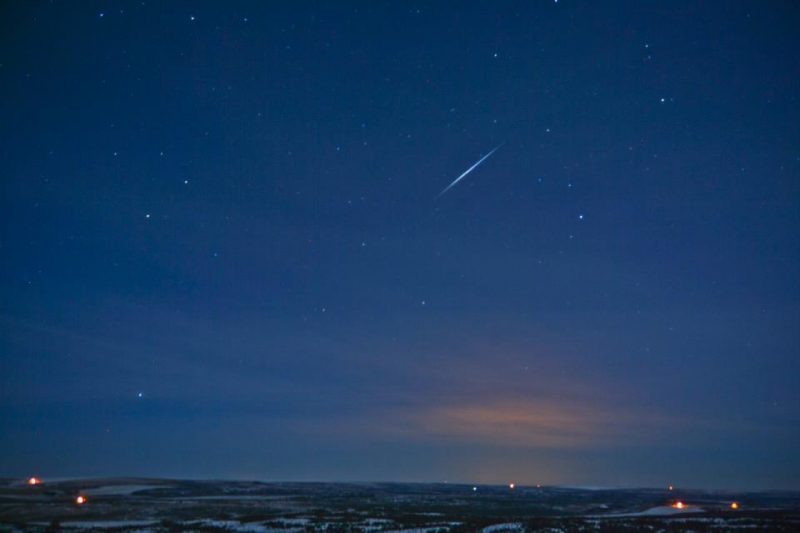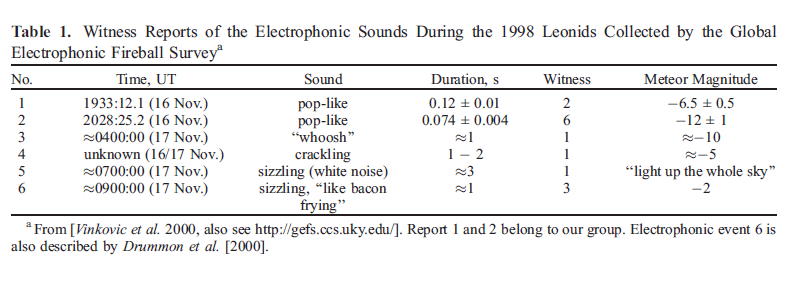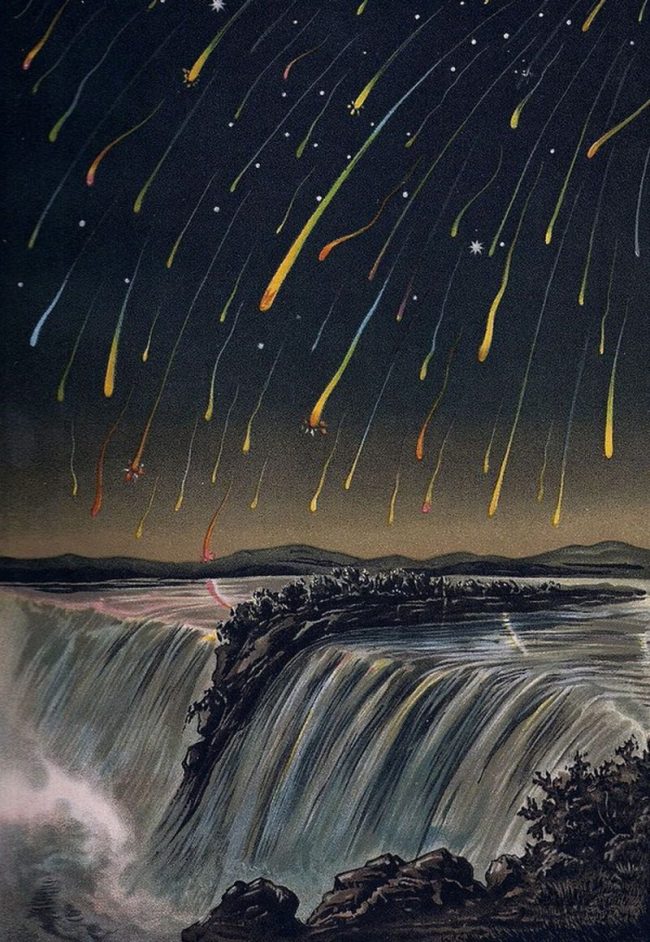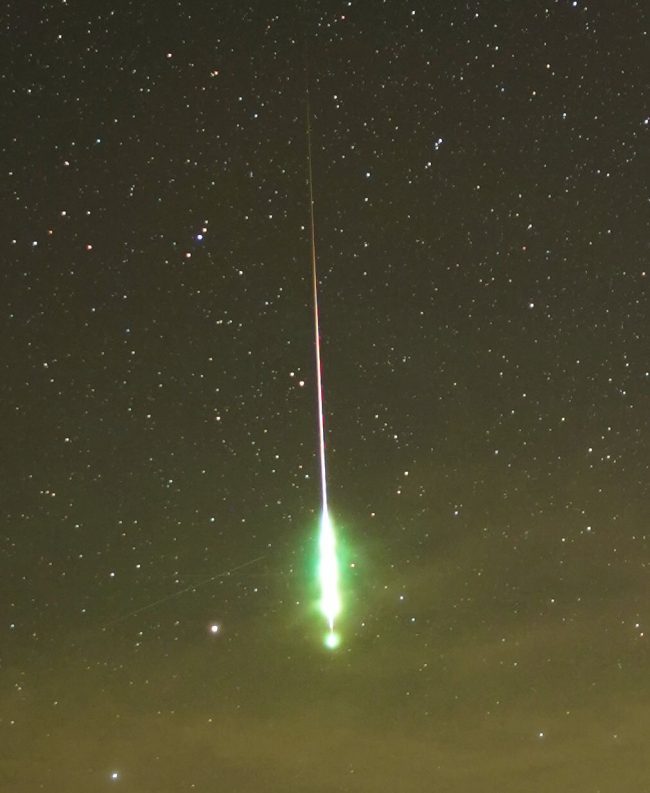
Is it possible to hear meteors?
Meteors are fun to see and can fill us with momentary awe. Those brief streaks of light are a reminder that many small rocky objects and even-smaller icy particles – most no bigger than sand grains – enter Earth’s atmosphere every hour of every day. Most burn up in Earth’s atmosphere and never reach Earth’s surface at all. Seeing them is fun and cool. But is it possible to hear meteors as well?
Sometimes, after a meteor shower, people report hearing the meteors as they disintegrate in the atmosphere. Some people report a low hissing sound, like bacon sizzling, when seeing exceptionally bright meteors. Is it really possible to hear meteors?
Astronomers now think it is.

Hearing VLF radio waves?
For years, professional astronomers dismissed the notion of sounds from meteors as fiction. Why? Typically, a meteor burns up about 60 miles (100 km) above the Earth’s surface. Sound travels so much more slowly than light does. We shouldn’t be able to hear the rumblings of a particularly large meteor for several minutes after the meteor’s sighting. It’s like hearing thunder after the lightning flashes have already happened.
A meteor 60 miles high booms about five minutes after it appears. This is a “sonic” meteor. The noise it makes is related to the sonic boom caused by a faster-than-sound aircraft.
But some meteors seem to make a sound at the same time that we see them. We hear and see these meteors simultaneously. Is this possible? Yes, astronomers say. These are what astronomers call electrophonic meteors.
Basically, the explanation is that these meteors give off very low frequency (VLF) radio waves, which travel at the speed of light. Even though you can’t directly hear radio waves, these waves can cause physical objects on the Earth’s surface to vibrate. The radio waves produce a sound, which our ears might interpret as the sizzle of a meteor shooting by.
Buzz, sizzle and hiss
In 2013, Live Science reported one classic example of people hearing meteors. It occurred in 817 A.D., as a meteor shower passed over China. Many observers reported hearing buzzing, sizzling or hissing sounds, according to a 1992 report by Colin Keay, a physicist at the University of Newcastle in Australia. Something similar happened in England in 1719.
Astronomer Edmond Halley said:
Of several accidents that were reported to have attended its passage, many were the effect of pure fantasy, such as the hearing it hiss as it went along, as if it had been near at hand.
The dismissal of these observations by suggesting that the sound perception may be psychological through “an affrighted imagination” set back the study of the phenomenon for nearly two centuries.

A 1978 meteor changes minds
It wasn’t until the 1970s and later that scientists began to take these reports more seriously. As Keay reported in the journal Asteroids, Comets, Meteors, people who claimed they could hear meteors were dismissed as crackpots.
But then, the sighting of a large meteor over New South Wales in 1978 caused hundreds of reports. Keay analyzed 36 of those reports.
VLF waves travel at the speed of light, so observers would hear them at the same time that they saw the meteors pass overhead. But those waves need something physical to act as a transducer and create the sound. Keay found that various objects such as aluminum foil, typing paper, plant foliage like pine needles, thin wires, dry frizzy hair and wire-framed eyeglasses could all produce those kinds of sounds. This phenomenon is called electrophonics.
A recent example from an observer pulls these objects into play:
When I was out [viewing the Leonid meteor showers in 1999], I had my head back on the ground and heard a sizzling sound. My head was close to grass and leaves and I wear wire-frame glasses as well. The sound was definitely simultaneous with the observation of a rather large streak.
Meteors over Mongolia
A team of scientists did an extensive study in Mongolia during the 1998 Leonids meteor shower. They took great care to find a location in:
…central Mongolia, devoid of life, any human or animal nocturnal activity, power lines, and AC electrical equipment of any sort.
The snow-covered plain was cold, -17° Fahrenheit (-27° C). Besides capturing audio recordings from two bright meteors, the visual observers also heard noises from the meteors. Here are their results and the results from other studies:

The sound precedes the brightest moment
And you typically hear the sound before the fireballs reach maximum brightness. The frequency of the sounds was in the 37 to 44 Hz range. The average person can hear between the frequencies of 20 to 20,000, so this is near the low end of that range. You have probably heard a 30-Hz sound if you have ever driven fast down the highway with your back window open.
How can you increase the chance of hearing meteors?
Here are some suggestions: lie down on a plastic tarp near dry leaves, frizz your hair, wear wire-framed eyeglasses and be near sheets of aluminum foil and typing paper. See a discussion and comments here.
It is not just meteors that produce low-frequency sounds. Aurorae, earthquakes and the re-entry of large rocket stages also produce electrophonic sounds.

Hearing more meteors than you can see?
Keay’s hypothesis got further testing during the Leonid meteor shower of November 18, 1999. The researchers detected distinct VLF sounds and also found that many of the meteors were not even visible by eye but were heard. In fact, they detected 50 times more meteors by their VLF signatures than by sight alone. Dennis Gallagher, a space physicist at the NASA Marshall Space Flight Center, said:
What makes this exciting is that we’re talking about a phenomenon that has been experienced by people for perhaps thousands of years. Even in modern times folks who reported hearing such sounds were ridiculed. It was only about 25 years ago that Keay was able to do the research and legitimize the experiences of all those generations of people. It shows there are still wonders in nature yet to be recognized and understood. We should take this experience with meteors as a reason to open our minds to what may yet be learned.
Fun fact: When meteoroids – rocky bodies from space as small as dust particles – are burning up in the atmosphere, they are called meteors. When one is large enough to survive entry into the atmosphere and hit the ground, it is called a meteorite.

Bottom line: Can you hear meteors as well as see them? Scientists say yes.











